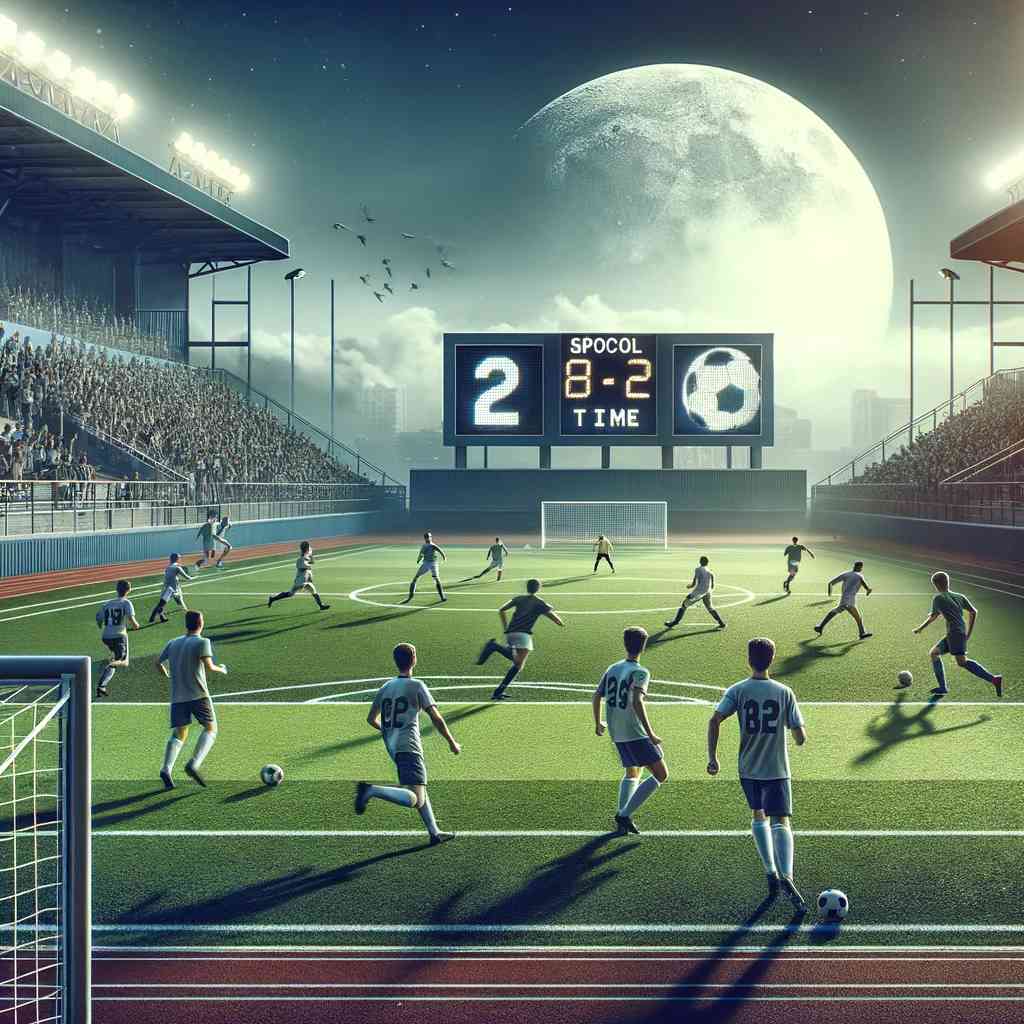Table of Contents
Sure thing, pal, let’s dive into the fantastic universe of high school soccer! Have you ever paused to think about how long a high school soccer game really lasts? It may seem like a simple question on the surface but trust me, there’s a whole lot of intrigue beneath. Today, we’re rolling up our sleeves and delving deep into the length of high school soccer matches while also exploring the captivating reasons behind their lasting charm.
Understanding Soccer
Before we start our timer, let’s talk basics. Soccer, as you probably know, is a game that’s played all over the world by people of all ages – from little kids chasing after a makeshift ball in backyard games to professionals sought after by club recruiters; the love for the beautiful game spans wide and far. In recent years, the excitement has spread to high schools across America. The rules? They aren’t quite as complicated as cricket or American football, though; both sports have two teams of eleven players competing to get the ball into the opponent’s goal. It’s simple yet bewitchingly strategic!
Duration of traditional soccer games
In professional soccer; which includes major international tournaments, top-tier club leagues and even regional competitions – a regulation game clocks in at 90 minutes: 45 minutes for each half with time thrown in for minor breaks. However, now you might be wondering – does that hold true for high school games? Hold on to your seatbelts because we are just about to explore that!
Why high school soccer games have specific durations
High School soccer games aren’t anywhere near as long as professional games. And nope, it’s not because they fear an invasion of teenage boredom! It actually boils down to two key factors: physiology and education. Teens’ bodies can’t withstand the same degree of extreme exercise as adults because they are still developing physiologically.
On top of that, the education factor kicks in. These games are often fitted into a school’s bustling schedule. Between classes, extracurricular activities, and the need for some downtime at home, games need to be played, enjoyed, and wrapped up all within time for dinner!
Rules determining length of high school soccer games
Okay, let’s talk official stuff here. The length of a high school soccer game is not randomly selected or left up to the whims of the coaches. It’s all very official and decided upon by folks known as the National Federation Of State High School Associations (NFHS). The NFHS bible, as we like to call it informally among friends, specifically dictates the length of high school soccer matches. And changes? Well, they can’t just be made willy-nilly – any adjustments go through a thorough process before they’re implemented.
Breakdown of a standard high school soccer game time
An average high school soccer showdown clocks in around 80 minutes, more or less. It’s neatly dissected into two parts, each spanning 40 minutes, with a well-deserved intermission lasting 10 minutes nestled between the halves. This breather provides an opportunity for players to rest, regain their strength and soak in strategic pep talks from their coaches. Extra time you ask? Unlike professional leagues which allow for an additional chunk of time for injuries and other unexpected stoppages during regular playtime known as ‘stoppage time’, this rule is usually not part the high school soccer scene.
Factors that can extend the length of the game
Now hold on! While technically a game sounds neatly packaged into 80 minutes plus a halftime break…things can get messy. Injuries unfortunately do happen (we know how that “accidental” trip wasn’t actually a coincidence, Brad!) and when they do, the clock takes a breather. Then there are penalties – yellow cards, red cards, warnings – every card flourish from the referee means more minutes added to your game-watch. So yes, sometimes it does feel like it’s been a long day on the field!
Complexities in Timing in Soccer Games
You might think keeping time in a soccer game is as easy as starting a stopwatch and stopping it when the game ends. Not so fast! There’s something called ‘stoppage time’ that comes into play. This sneaky little chunk of time isn’t accounted for initially but is added at the end of each half to make up for lost playing time during the match due to injuries or substitutions. Wait, there’s more – the timing is quite discretionary depending on our referee friend’s judgement, adding an exciting flavour of unpredictability to the match!
Effects of Weather Conditions on Game Length
Imagine that on the day of the event, you are prepared to take the field, but what happens? Like there is no tomorrow, it is pouring. So what happens now? Weather swings have profound effects on how long a soccer game lasts. Heavy rain or lightning can lead to delays or even match cancellations.
Snow, counter-intuitively, might not be a complete party pooper; games can sometimes go on with some true snowy flavor, though they may require extra breaks for snow removal (bet none of you thought you’d be asked to bring your shovels along with your shin guards!). So yeah, weather does like to throw curveballs into our neatly organized game durations.
Comparing Game Durations across Different Levels
You’d think that soccer is soccer irrespective of who plays it. But surprise – high school matches differ in duration from elementary, middle school, and college games!
Elementary level games are usually shorter keeping in line with younger player stamina capacities and snack-time urgencies (let’s admit it guys!), while at the other extreme – college games ramp up duration more in line with professional matches. All the steps are measured taking into account player readiness and of course, compulsory education hours.
Impact of Game Duration on Player Performance and Safety
Beyond the complex rules, timings, and snack breaks (because they’re crucial!), there lies a fundamental consideration that guides game duration – player performance and safety. The physical strain from running around a soccer field isn’t something to sneeze at! Plus, bodies in motion tend to sometimes collide leading to minor or not-so-minor injuries, more so if the game stretches beyond player’s comfort zones.
Not forgetting, recovery time is essential in any sport – muscles need to chill after all that sprinting and sliding. That again plays into determining ideal high school match lengths.
Role and Responsibility of Coaching Staff Pertaining to Game Duration
Credit where credit’s due – our beloved coaches bear an immense responsibility during each game. Not only do they act as real-time strategy makers but also as caretakers managing player workload during games. Adjustments are often made depending upon game length – formation tweaks, player rotations, pacing strategies – you name it!
They also dictate half-time pep talks and manage injury fallouts effectively. So kudos to our cap-wearing whistle-blowing tacticians who manage these games aptly within their prescribed durations!
Effect of Game Duration on Spectator Experience
The players aren’t alone on this journey – let’s not forget about us cheering (or jeering) from the stands! A breezy 80-minute match might be a pleasure for some while others would love for it to stretch longer – more thrills, twists, and turns! Unobtrusive in principle but yet integral – the duration does play its part in keeping us hooked till the end; or otherwise scrolling through our phones!
Pregame Preparation: How Long Sessions Should Last for Players
Did you know, before players even set foot on that pitch, they’ve been warming up? Stretching those muscles, getting their heartbeats up and going through tactical drills – all warming up to the grand play! The length of these sessions isn’t random either, matching to the game’s length among other elements. You wouldn’t be running a marathon in order to prepare for a sprint, after all.
A talk on high school soccer would be incomplete if it did not include an analysis of the pregame drills and strategies employed before the whistle blows. Players benefit from these exercises by becoming more mentally and physically ready for what’s to come. They also set the stage for a great spectator experience.
Case Study: Effects of Game Duration Changes in Different States
Did you know that not all high school soccer games around the country last the same length? Yes, you heard that right! Across different states, minor differences in game lengths exist, mostly rounding up to close figures but varied nonetheless. This could be influenced by regional preferences or other factors within the education system of a particular state. For example, midwestern states may have slightly different rules than those on both coasts due to varying weather patterns and daylight times.
Insights From Professional High School Soccer Coaches
You’d be surprised how much these whistle-yielding figures on the sidelines can share about the intricacies behind each game’s duration! Insights drawn directly from professional high school soccer coaches reveal a world of strategizing that revolves around this deceptively simple factor. Balancing player fatigue, honing in their focus for the game’s length, crafting strategies that exploit timing – oh boy, game length sure is more than just minutes ticking away!
Frequently Asked Questions About High School Soccer Games
We’ve all had them at some point or another – questions ranging from curiosity to utterly bizarre ones about high school soccer games. Wondering if aliens ever played soccer might not find many answers (though we’d love to see them try!), but ‘how long does it take for a thrown-out player to return?’, ‘how long is half-time?’, and ‘does injury time include alien invasions?’ – these are just a few of the myriad questions roaming about in the soccer sphere! And trust me, folding these queries into insightful answers adds another layer to our understanding of high school soccer match durations.
Future Predictions: Possible Changes in High School Soccer Game Duration
Looking ahead, a fascinating question to pose is – will the duration of high school soccer games change? As fitness levels evolve and newer research insights seep into the planning mechanisms, tweaks in game length could be a future possibility. Potentially, innovations targeted at optimizing player performance, enhancing spectator experience, or utilizing available daylight more effectively could all drive adaptations to current norms. So keep those stopwatches handy – the future may bring some exciting changes!
How Long Are High School Soccer Games Compared to Preschool Hours?
High school soccer games typically last about 90 minutes, but the actual playing time is only 80 minutes. In contrast, preschool hours explained are usually around 3-4 hours long. The difference in duration reflects the varying attention spans and physical capabilities of the different age groups.
Conclusion
So, my friend, our journey navigating through the intricacies of high school soccer games has been both enlightening and immensely enjoyable for me. I hope you feel the same way! From understanding basic rules of soccer and exploring game durations across various levels, to delving into the role of coaches, spectator experiences and future predictions – we’ve covered quite some ground! Remember though, regardless of how long it lasts or will last – at its heart, soccer remains a beautiful game with room for everyone from players to spectators enjoying each vibrant second!
References
While our chat has come to an end (for now!), do check out the National Federation Of State High School Associations (NFHS) for all things official about high school sports in America. For broader knowledge, FIFA remains an essential go-to source for a global perspective on this beloved game.
Exciting discussions await ahead and until next time – keep playing, keep loving soccer!

